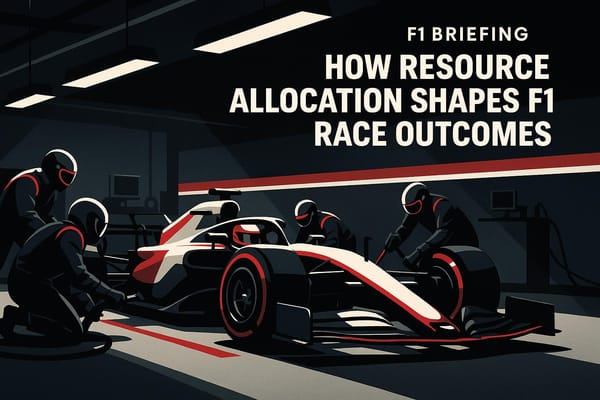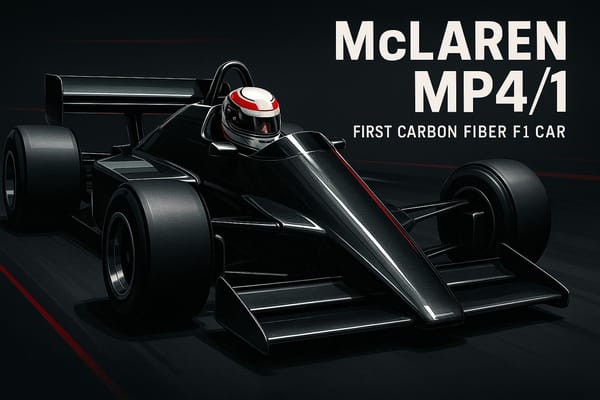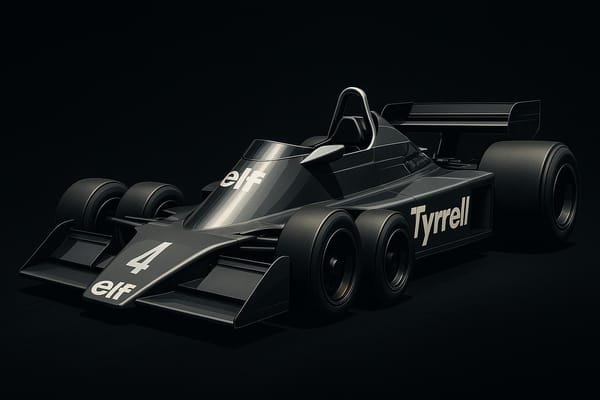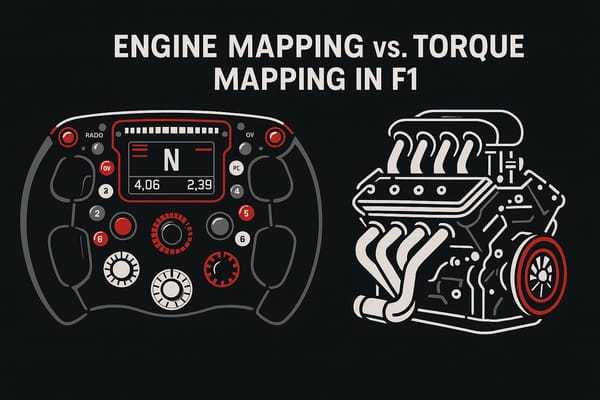Driver Behavior Modeling with F1 Telemetry
Explore how F1 teams leverage telemetry data to analyze driver behavior, optimize race strategies, and enhance performance through advanced technology.
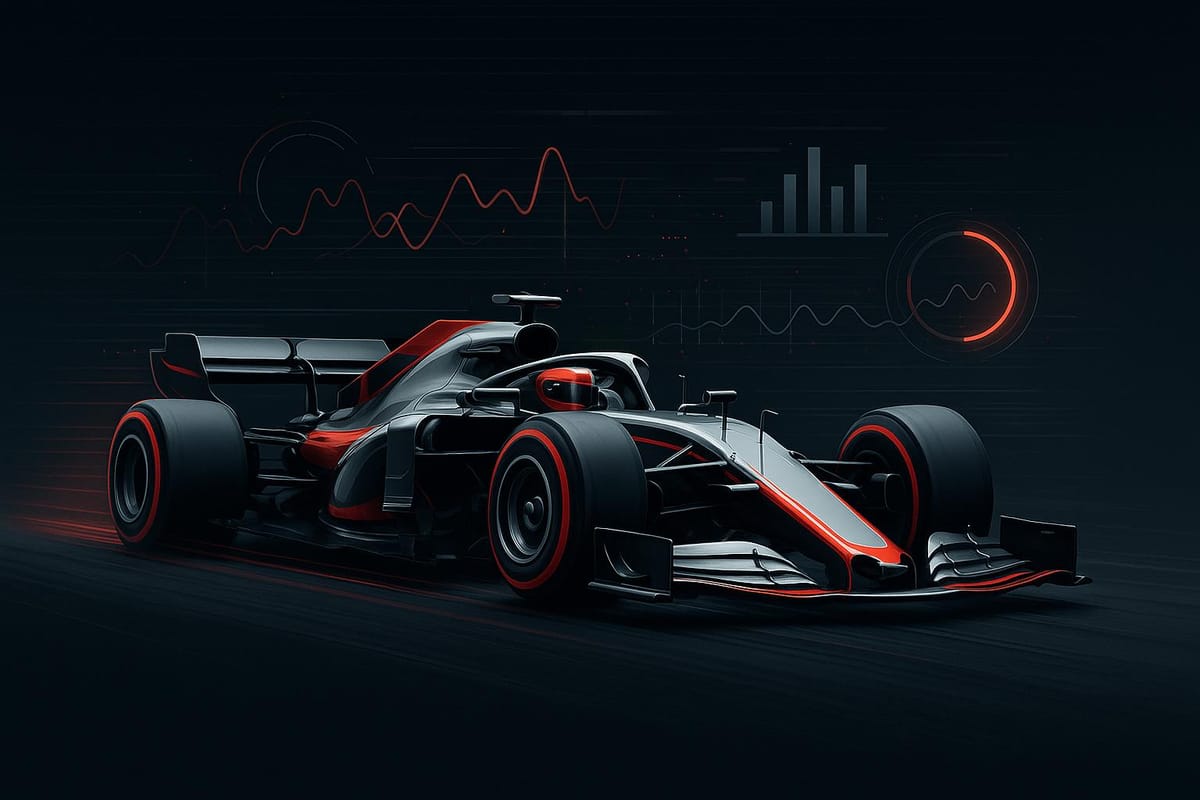
Formula One racing thrives on data. Every F1 car generates 1.1 million telemetry data points per second, equating to 35 MB per 2-minute lap. This data reveals how drivers brake, accelerate, and corner, helping teams refine strategies and improve performance. Here's what you need to know:
- Telemetry Basics: Over 300 sensors monitor tire pressure, engine health, and driver inputs in real time.
- Driver Behavior Insights: Data highlights each driver's unique style - like aggressive braking or smooth cornering.
- Race Strategies: Teams use telemetry to optimize pit stops, tire choices, and fuel consumption.
- Post-Race Analysis: Engineers analyze 400 GB of race data to improve car setups and driver skills.
- Technology: AI and machine learning predict tire wear, fuel usage, and race outcomes, while visualization tools simplify decision-making.
This blend of real-time and post-race analysis ensures every millisecond counts on the track. Read on to explore how F1 teams harness telemetry for a competitive edge.
Former F1 Data Engineer Explains Race Telemetry | MoTeC [#TECHTALK]

How F1 Teams Collect and Process Telemetry Data
Transforming raw sensor readings into actionable race strategies is no small feat. It all starts with a sophisticated network of sensors and a carefully designed data pipeline. Modern Formula 1 teams rely on these systems to capture and analyze the performance of their cars and drivers.
Key Telemetry Data Points in F1
During a typical race weekend, an F1 car is equipped with more than 250 sensors, each serving a unique purpose. These sensors fall into three primary categories: control sensors (tracking driver inputs), instrumentation sensors (measuring performance metrics like pressure and fuel flow), and monitoring sensors (ensuring the car's systems are functioning properly).
Christine Steven, Lead Electronics Development Engineer at Mercedes, explains:
"There are over 250 sensors on the car during an average race weekend, and these can be divided into three main categories: control, instrumentation, and monitoring. All of this delivers pressure temperature, inertial, and displacement data."
The data collected includes temperature, pressure, inertial, and displacement measurements. For example, temperature sensors use infrared energy to monitor engine heat, airbox conditions, and friction between moving components without direct contact. Tire sensors deliver real-time insights into wear, grip, temperature, and pressure. Meanwhile, accelerometers and dual-axis sensors track g-forces, braking, and steering inputs, while pressure sensors monitor hydraulic systems. Additional tools like pitot tubes, ultrasonic fluid flow sensors, lasers, and damper potentiometers further enrich the data.
Chris Nelson, a Trackside Control Systems Engineer, highlights the breadth of data these sensors provide:
"So with sensors all over the car, we receive data from all aspects of the vehicle behaviour, driver inputs, and driver performance. For example, we can see exactly what the driver is doing in terms of braking inputs, throttle steering angle, what buttons and switches he's changing on the steering wheel, and also overall car performance..."
Real-Time Data Transmission Systems
Sending vast amounts of data from a car traveling over 200 mph to engineers in the pit lane is no small challenge. F1 teams use a mix of infrared signals, radio waves, and fiber-optic systems to ensure real-time data flow. Over the course of a race weekend, approximately 160 terabytes of data are transmitted between the circuit and the F1 Media and Technology Center.
To ensure reliability and security, the FIA enforces strict rules for data transmission. Teams are assigned specific communication frequencies to prevent interference, and encryption protocols protect against data breaches. Backup systems, such as direct radio updates, are also in place in case of telemetry failures.
Evan Short, Team Leader of Trackside Electronics Systems at Mercedes, reflects on the evolution of telemetry systems:
"We used to set up our own masts, radios, and telemetry systems, and we decided in the end that that wasn't the competition we were in. We want to be racing each other on track. There's no point in having a race between the people setting up the antennas."
This move toward standardization ensures all teams have equal access to reliable data transmission, allowing them to focus on performance rather than infrastructure.
Preparing Raw Data for Analysis
Once securely transmitted, the raw sensor data undergoes a rigorous processing phase. A single Formula 1 car generates roughly 35 megabytes of raw data every two minutes - equivalent to one lap. The first step in processing this data involves cleaning and synchronizing it. Engineers use methods like interpolation and binning to fill in missing data and reduce noise. Synchronization across sensors operating at different frequencies is crucial to create a clear timeline, ensuring driver inputs align perfectly with performance metrics.
Next, the cleaned data is subjected to validation checks to identify anomalies or potential sensor issues. Once verified, the data is fed into specialized software designed to handle the complexity and volume of F1 telemetry. This process helps teams uncover important patterns in driver behavior and car performance, enabling on-the-spot strategy changes and detailed post-session reviews to refine both car setup and driver skills.
Methods for Analyzing Driver Behavior from Telemetry
Telemetry data provides a detailed window into driver behavior, helping teams decipher performance on the track. By combining traditional analysis methods with cutting-edge machine learning, engineers can break down not just what happens during a race but also uncover the reasons behind it - and find ways to improve.
Analyzing Driver Inputs and Controls
The first step in driver behavior analysis revolves around studying inputs like throttle, brake, steering, and gear changes. Engineers focus on how drivers juggle power, traction, and deceleration across various sections of the track. This reveals key details about a driver’s technique, their consistency, and how they adapt to evolving race conditions.
For example, braking patterns can shed light on how aggressively a driver approaches corners and how they modulate brake pressure mid-turn. Similarly, throttle data highlights how drivers manage power delivery, especially when exiting corners where maintaining traction is critical. Steering inputs and gear shifts further demonstrate how well a driver maximizes engine performance across different track segments.
Beyond these foundational metrics, advanced statistical models now offer deeper insights into driver behavior.
Using Statistics and Machine Learning for Driver Analysis
Today’s Formula 1 teams leverage advanced analytics to uncover patterns that traditional methods might miss. Machine learning algorithms, for instance, can predict tire wear, fuel usage, and even the best times for pit stops by integrating historical and live telemetry data.
Take Scuderia Ferrari HP as an example. In March 2024, the team tested a pit stop analysis system powered by AWS machine learning, which became operational by April 2024. Using Amazon SageMaker AI, the system synchronizes video footage with telemetry data from pit crew equipment, cutting data synchronization times by up to 80% and processing pit stop information in just 60–90 seconds.
"Previously, we had to manually analyze multiple video recordings and telemetry data separately, making it difficult to identify inefficiencies and increasing the risk of missing critical details. With this new approach, we can now automate and centralize the analysis, gaining a clearer and more immediate understanding of every pit stop, helping us detect errors faster and refine our processes."
– Marco Gaudino, Digital Transformation Racing Application Architect
Statistical models are also proving their worth. For example, an Extreme Gradient Boosting (XGBoost) model achieved an impressive 92.2% accuracy in predicting lap times by combining data from diverse sources. Meanwhile, reinforcement learning models are being explored to monitor tire wear in real time and suggest race adjustments, though their computational demands remain a hurdle.
These insights set the stage for visualization tools, which transform raw data into actionable strategies.
Visual Tools for Understanding Driving Styles
Visualization tools play a crucial role in turning telemetry data into insights that are easy to interpret. These tools are invaluable both during the heat of a race and for detailed reviews afterward. For instance, 3D track visualizations use color gradients - blue for lower speeds, red for higher speeds - to highlight key areas like braking zones, cornering, and acceleration.
Other popular tools include heatmaps that map speed and gear usage across the track, multi-line charts that compare metrics like acceleration, brake intensity, and engine RPM over multiple laps, and scatter plots that show the relationship between speed and engine performance. For real-time monitoring, dashboards integrate live data such as engine RPM, speed, and gear usage with 3D track representations displaying car positions in real time.
Libraries like FastF1 and visualization platforms like LightningChart empower teams to turn massive amounts of raw telemetry into straightforward, actionable visuals.
How Driver Behavior Modeling Affects Race Strategy
Racing teams today are achieving new levels of precision by using driver behavior data to shape race-day tactics and long-term performance strategies. This goes well beyond just tracking performance metrics; it’s about rethinking how teams compete and prepare for the challenges ahead.
"In F1, where precision and split-second decisions can make or break a team's success, data-driven analytics has become essential to every winning strategy."
Making Real-Time Strategy Decisions
During a Grand Prix, live telemetry is a game-changer. Teams rely on real-time data to make crucial decisions that can influence the outcome of a race. This data includes tire pressure, engine temperatures, brake conditions, and fuel levels, all of which provide a snapshot of how the car and driver are performing at any given moment.
Driver inputs - like braking, throttle usage, and cornering - are closely monitored to assess tire wear and changing track conditions. This information is vital for determining the best times for pit stops, selecting the right tire compounds, and deciding how aggressively a driver should push the car.
Machine learning takes this a step further by predicting tire degradation, fuel consumption trends, and even the probability of safety car deployments. These forecasts allow teams to create flexible strategies that can adjust to the ever-changing dynamics of a race. With live telemetry, teams can react instantly to unexpected developments, ensuring they stay competitive.
Once the race is over, the focus shifts to dissecting the data collected to enhance future performance.
Post-Race Analysis and Driver Coaching
Every race generates a staggering 400 GB of data, which teams meticulously analyze to find areas for improvement. Engineers dive into telemetry data - covering speed, throttle and brake usage, and tire temperatures - to evaluate the car’s performance. This technical data is paired with video footage from onboard and external cameras to pinpoint driver mistakes, track condition changes, and missed overtaking opportunities.
"Telemetry furnishes comprehensive insights into both the vehicle and the driver. It allows teams to discern reasons behind performance differentials... Moreover, it aids in diagnosing persistent issues like braking inconsistencies." - Yashovardhan Sharma, Editor
Post-race debriefs are heavily focused on driver development. Engineers analyze sections where lap times lagged to determine whether the problem was due to the car’s setup, driving technique, or a strategic misstep. This detailed analysis feeds into tailored coaching programs aimed at addressing individual weaknesses and refining driving techniques. Advanced tools with visualization and scenario testing features make it easier to identify what worked and what didn’t.
Real-Time vs. Post-Race Analysis Comparison
The key difference between real-time and post-race analysis lies in their objectives and the time available to process data:
| Aspect | Real-Time Analysis | Post-Race Analysis |
|---|---|---|
| Primary Focus | Immediate decisions (pit stops, tire changes, fuel usage) | Long-term improvements and strategy refinement |
| Time Available | Seconds to minutes | Hours to days |
| Data Processing | Focused on critical metrics | Comprehensive review of all collected data |
| Decision Impact | Affects the current race | Shapes future race strategies and performance |
Real-time analysis is all about making quick, impactful decisions during the race, often with limited data. On the other hand, post-race analysis uses the full dataset to identify patterns and develop strategies for consistent improvement.
"Telemetry serves as the performance pulse, providing teams with critical insights into their car's behaviour on the track."
Both approaches are indispensable in Formula 1. While real-time decisions can secure immediate results, the insights gained post-race are what drive long-term success and innovation in this highly competitive sport.
Current Challenges and Future of Driver Behavior Modeling
Formula 1 teams have made strides in using telemetry to understand driver behavior, but significant hurdles remain. At the same time, cutting-edge technologies are opening doors to new possibilities, potentially reshaping how teams analyze and optimize performance on the track.
Technical Challenges in Current Telemetry Systems
F1 cars are equipped with over 300 sensors, generating more than 1.1 million data points per second. This sheer volume of data is both a blessing and a challenge. Real-time analysis often encounters roadblocks due to occasional data blackouts caused by environmental or technical issues . These interruptions are particularly critical during high-stakes race moments, where split-second decisions can make or break a race.
"We used to have a recurring issue with the web API system, which was slow to respond and provided inconsistent outputs. Teams spent around 15 full engineer days to iteratively resolve the issue over several events: reviewing logs, inspecting anomalies, and iterating on the fixes."
– Lee Wright, Head of IT Operations at Formula 1
The data overload also creates processing bottlenecks. For instance, a single car can produce 4 TB of data per race. Engineers often struggle to sift through this constant stream of information to pinpoint the most critical data points, which can lead to delays or less-than-optimal decisions during races.
Cybersecurity is another pressing concern. Teams face threats like digital espionage and ransomware attacks, which could compromise the integrity of their data.
"Track time and F1 is a very limited resource. We cannot go out and repeat a test if something goes wrong, so the pressure is on to get it right the first time."
– Evan Short, Team Leader of Trackside Electronics Systems at Mercedes F1
These challenges highlight the need for advanced solutions that can streamline data processing and fortify security measures.
New Technologies in Telemetry and Driver Analysis
Artificial intelligence (AI) and machine learning are already reshaping how teams process and interpret driver data. These tools not only analyze current conditions but also predict future scenarios, helping teams adapt strategies on the fly .
"The AI doesn't just look at what's happening now; it looks at what's going to happen next."
– F1 Engineer
New advancements in data processing have also made a significant impact. For example, during the Chinese Grand Prix in March 2025, one team utilized Riverbed Acceleration technology to achieve data reduction rates of up to 75%. As a result, data transfers that previously took over two hours now take under 20 minutes.
"Just like with our cars on the track, anything that can be done to speed up the movement of data is seen as a competitive advantage. In short it has been a game changer. Even more so in the current times of cost caps and needing to maximize our assets."
– F1 Customer of BGN and Riverbed
Cloud computing has also revolutionized aerodynamic simulations. What once took four days to simulate now takes just eight hours, allowing teams to test more configurations and better understand how driver behavior interacts with car performance.
These technological breakthroughs are setting the stage for a future where data precision drives every decision.
The Future of F1 Driver Performance Analysis
The road ahead for driver behavior modeling lies in further integrating advanced data analytics and real-time AI systems. By overcoming current technical and cybersecurity challenges, teams will be able to unlock even faster and more detailed insights into driver performance. These improvements could lead to more accurate and strategic decision-making during races.
However, challenges such as cost constraints and potential AI bias remain. As teams grow more skilled at analyzing telemetry data, the margin for error will shrink, and the ability to extract every ounce of performance from driver behavior will become even more vital to success in Formula 1.
Conclusion
Telemetry-driven driver behavior modeling has reshaped Formula One into a sport where precision analytics reign supreme. Each car generates an astonishing 1.5 TB of data per weekend, collected from over 300 sensors capturing 1.1 million data points every second. This massive influx of information has shifted decision-making from gut instinct to data-backed strategies, transforming every aspect of racing operations.
This data revolution doesn’t just refine race-day strategies - it also drives targeted driver development. As Christian Horner, CEO of Oracle Red Bull Racing, puts it:
"Data analytics is integral to our team's performance strategy. From developing cars to improving performance, selecting and analysing drivers is done through data analytics."
By leveraging these insights, teams can create highly personalized training programs for drivers and gain strategic advantages through real-time analysis. This ensures that every fraction of a second - every ounce of potential - is maximized, both from the car and the driver.
Looking ahead, the role of technology in Formula One is only set to grow. Artificial intelligence and machine learning are poised to take driver behavior modeling to new heights, while advanced data visualization tools and cloud-based platforms are simplifying the process of extracting actionable insights from vast telemetry datasets. As Otmar Szafnauer, CEO and Team Principal at Aston Martin Cognizant Formula One, highlights:
"Formula One teams have always been pioneers in analyzing data for a competitive advantage, especially when milliseconds mean the difference between pole position and starting somewhere in the middle of the pack."
Driver behavior modeling is a testament to Formula One's relentless quest for perfection. With viewership doubling between 2018 and 2023, averaging 1.11 million viewers per race, fans are increasingly captivated by the intricate data-driven decisions that underpin every move on the track. This seamless blend of cutting-edge technology and human skill continues to push the limits of what’s achievable in motorsport, ensuring that Formula One remains a global leader in both athletic performance and technological innovation.
FAQs
How do Formula 1 teams keep telemetry data secure and reliable during races?
Formula 1 teams depend on cutting-edge technology and rigorous protocols to safeguard telemetry data during races. They use encrypted radio waves, infrared signals, and fiber-optic systems to transmit real-time data from the car to the pit wall, ensuring it stays protected from cyber threats and unauthorized access.
To keep their systems running smoothly, teams constantly evaluate them for potential issues like signal interference or electronic noise. Access to sensitive data is tightly controlled and limited to authorized team members, allowing critical information to remain secure while supporting quick, strategic decision-making during the race.
How does machine learning improve race strategies and driver performance in Formula 1?
The Role of Machine Learning in Formula 1
Machine learning has become a game-changer in Formula 1, helping teams fine-tune race strategies and boost driver performance by crunching massive amounts of telemetry data. This data covers everything from tire wear and fuel consumption to vehicle dynamics, giving teams the tools to make real-time, data-backed decisions. For instance, predictive models can estimate how quickly tires will degrade or how much fuel a car will burn, allowing teams to schedule pit stops and adjust race tactics with precision.
But it doesn’t stop there. Machine learning also dives deep into driver behavior and performance trends, uncovering details like the best braking points, ideal cornering techniques, and unique driving styles. Armed with this information, teams can tweak strategies on the fly, sharpening both individual driver skills and overall team performance in a sport where every second counts.
How do F1 teams use telemetry data to enhance driver performance and car optimization after a race?
How F1 Teams Use Telemetry Data
F1 teams depend heavily on telemetry data to fine-tune both driver performance and car setups after every race. By equipping the car with sensors, they gather real-time information on critical metrics such as speed, throttle input, brake pressure, and tire behavior. This data allows engineers to pinpoint areas for improvement - whether it’s tweaking braking techniques or adjusting throttle control during cornering to enhance stability and shave off precious seconds from lap times.
Telemetry isn’t just about the short-term, though. It’s a key player in shaping long-term strategies. By studying historical data, teams can spot patterns, improve car designs, and craft race strategies tailored to specific tracks. This constant flow of feedback ensures that both the car and the driver are always evolving to stay at the top of their game.

